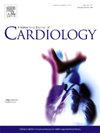退行性二尖瓣返流手术修复后经瓣梯度的危险因素及临床影响。
IF 3.2
2区 医学
Q2 CARDIAC & CARDIOVASCULAR SYSTEMS
引用次数: 0
摘要
目的:二尖瓣返流(MR)修复后功能性二尖瓣狭窄(FMS)尚不清楚。我们的目的是评估退行性MR手术修复后患者FMS的危险因素及其临床影响。方法:纳入2016年1月至2023年3月接受退行性MR手术修复的患者。出院前二尖瓣梯度≥5 mmHg的患者考虑FMS。患者与基线特征进行1:1倾向评分匹配(PSM)。采用多因素logistic回归来确定发生FMS的危险因素。通过Kaplan-Meier法和多元Cox回归分析事件时间数据。本研究的主要结局是mr的死亡率和复发率。结果:该队列包括510例患者(FMS患者 = 99,无FMS患者 = 411)。平均临床随访时间为51.6 个月。FMS研究组术前射血分数低于非FMS组(53.7 ± 7.4 vs 55.5 ± 7.4,p = 0.04)。多变量回归报告了环成形术的灵活性(p = 0.001)和更小的环尺寸(p )。结论:本研究确定了影响退行性二尖瓣修复后FMS发展的手术因素。FMS与术后MR相关,需要进一步研究以了解修复技术如何影响术后MR和FMS。本文章由计算机程序翻译,如有差异,请以英文原文为准。
Risk factors and clinical impact of transvalvular gradient following surgical repair of degenerative mitral regurgitation
Objective
Functional mitral stenosis (FMS) following mitral regurgitation (MR) repair is poorly understood. We aim to assess risk factors of FMS and its clinical impact in patients following the surgical repair of degenerative MR.
Methods
Patients who underwent surgical repair of degenerative MR between January 2016 and March 2023 were included. FMS was considered in patients with a pre-discharge mitral valve gradient ≥5 mmHg. Patients were 1:1 propensity score matched (PSM) by baseline characteristics. Multivariate logistic regression was employed to identify risk factors for developing FMS. Time-to-event data were analysed via the Kaplan-Meier method and multivariate Cox regression. The primary outcomes of our study were mortality and recurrence of MR.
Results
The cohort comprised of 510 patients (FMS n = 99, no-FMS n = 411). Mean clinical follow-up was 51.6 months. The FMS study group demonstrated a lower preoperative ejection fraction than the no-FMS group (53.7 ± 7.4 versus 55.5 ± 7.4, p = 0.04). Multivariate regression reported annuloplasty flexibility (p = 0.001), smaller ring size (p < 0.001), edge-to-edge repair (p = 0.003), and increased cardiopulmonary bypass time (p = 0.03) as risk factors for developing FMS. The PSM cohort (groups n = 99) demonstrated FMS development is associated with recurrence of ≥MR2+ (p = 0.04); however, was not significant following multivariate regression (p = 0.21). A survival benefit trend was observed in the raw no-FMS group (16.2 % versus 10.7 %); however, this did not reach statistical significance (p = 0.22).
Conclusions
This study has identified surgical factors significantly affecting FMS development after degenerative mitral valve repair. FMS was associated with postoperative MR. Further research is required to understand how repair techniques affect postoperative MR and FMS.
求助全文
通过发布文献求助,成功后即可免费获取论文全文。
去求助
来源期刊

International journal of cardiology
医学-心血管系统
CiteScore
6.80
自引率
5.70%
发文量
758
审稿时长
44 days
期刊介绍:
The International Journal of Cardiology is devoted to cardiology in the broadest sense. Both basic research and clinical papers can be submitted. The journal serves the interest of both practicing clinicians and researchers.
In addition to original papers, we are launching a range of new manuscript types, including Consensus and Position Papers, Systematic Reviews, Meta-analyses, and Short communications. Case reports are no longer acceptable. Controversial techniques, issues on health policy and social medicine are discussed and serve as useful tools for encouraging debate.
 求助内容:
求助内容: 应助结果提醒方式:
应助结果提醒方式:


